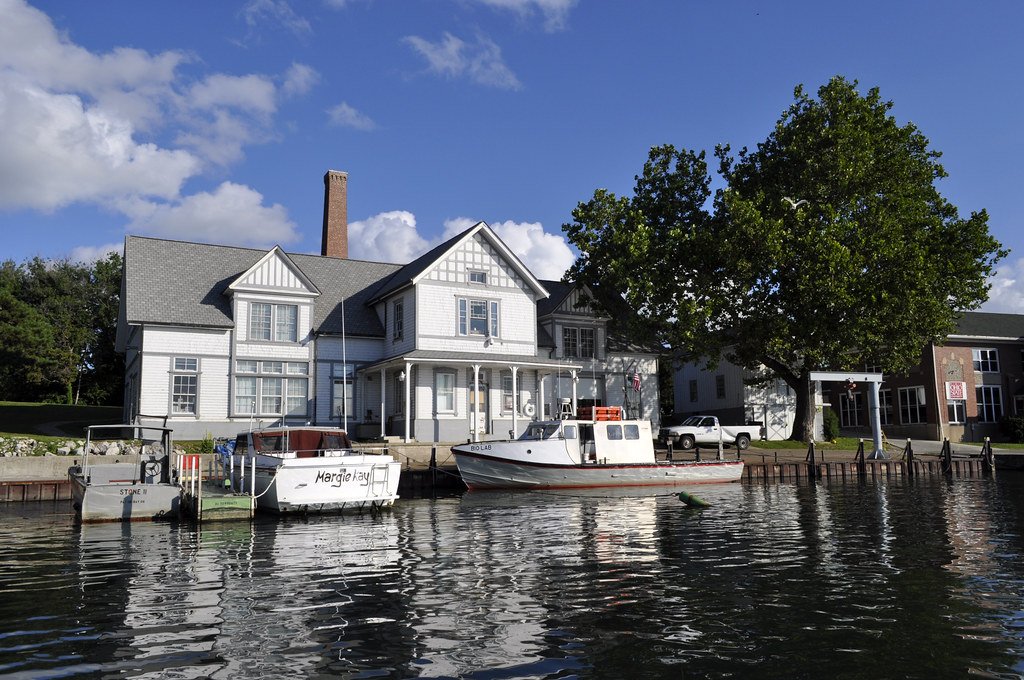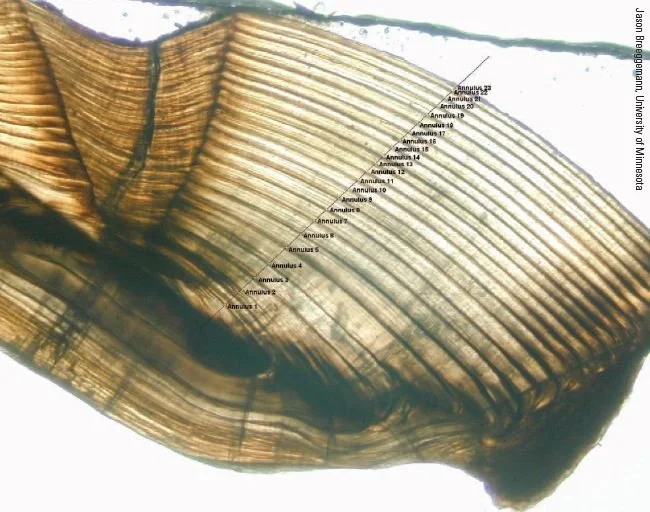A Summer of Learning
Stone Lab classes give students the opportunity to experience field science first-hand, to catch up on college credits or get a head start on major requirements, and to simply have a great time learning with other students. Of course, for some students, a Stone Lab summer can be all of those things and more.
Teacher at Sea
Professional development for teachers can come in many forms, from online lectures to week-long field experiences and everything in between. One of the most competitive options out there is the Teacher at Sea Program, run by the National Oceanographic and Atmospheric Administration (NOAA). More than 200 teachers apply to the program each year, but less than 30 are usually selected to join NOAA researchers in the field.
This year, Stone Lab Education and Outreach Associate Angela Greene was one of those teachers. Greene, who teaches science at Tecumseh Middle School in New Carlisle, Ohio, sailed on the NOAA ship Gordon Gunter, and participated in a survey of northern right whale populations in the North Atlantic.

Ohio Study Shows the Value of Lake Erie Shoreline Recreational Fishing
Lake Erie shoreline anglers — those who fish from shore locations like docks and jetties instead of boats – value their fishing at an annual average of $13.5 million, a study from Ohio State University Extension, Ohio Sea Grant, and the Ohio Department of Natural Resources (ODNR) Division of Wildlife has found. Shoreline anglers also spend an additional $1.1 million in communities near their fishing destinations on things like food, gas, and last-minute supplies.
Lessons from History
We’ve all seen them: communities along the Lake Erie shoreline that once played host to thriving industrial and manufacturing businesses, but have fallen on hard times as those industries move away. Many Lake Erie cities are now trying to take advantage of their location on the shoreline to attract visitors, focusing on tourism as the major industry in town. But some economists worry that switching from one exclusive industry focus – manufacturing – to another – tourism – could lead to the same problems as before if tourism becomes negatively affected.

Predicting the Bloom
Bright green waters, often capped with foam. Floating mats of algae washing up on the shoreline. And an invisible toxin that can cause rashes, breathing and nervous system problems, and liver damage.
Harmful algal blooms (HABs) can have many negative impacts on the Lake Erie ecosystem and its economy, from deterring tourist visits to fouling drinking water. But as with most problems, being able to prepare means those impacts can be reduced or avoided altogether.

Exploring Climate Change in the Great Lakes Region
Climate change is often considered an abstract concept, affecting far-flung parts of the world like the Arctic, but not really relevant to life around the Great Lakes. However, research indicates that climate change will cause noticeable changes in the region, from changes in weather patterns to sightings of new plant and animal species.
With changing environments comes a need to educate area residents – children and adults alike – about the changes, and about the “new normal” they can expect to see in the future. Ohio State University’s Stone Lab is doing just that, with a new activity for its Lake Erie Science Field Trip Program.

Stone Lab Water Quality Lab Gets Ready for Its Close-Up
Last year already saw a number of improvements at Stone Laboratory, but renovations and updates continue on South Bass and Gibraltar Islands. The newest addition to Stone Lab’s facilities will be an Algae & Water Quality Lab, housed in the Stone Lab Research Building and slated to open this summer.

History & Science on the High Seas
“We have met the enemy, and they are ours.”
Those now-famous words from Commodore Oliver Hazard Perry after the Battle of Lake Erie were written aboard the Brig Niagara, a two-mast tall ship that became the American flagship during the 1813 battle with the British fleet. But the Niagara’s claim to fame doesn’t end in the pages of history books – a replica of the ship still sails the Great Lakes today, serving as a backdrop for history lessons, sailing courses, and college classes.
The Ultimate Recycling
An essential part of keeping a Lake Erie port operating is dredging shipping lanes to maintain adequate depth for water traffic, whether that’s small fishing boats or large freighters. But what to do with the material that gets scooped up from the bottom of the lake? In many cases, it’s dumped in open lake waters, or impounded in lots near the harbor. But Dr. Elizabeth Dayton, Research Scientist at Ohio State University’s School of Environment & Natural Resources, believes the dredge material can be put to better use.

Listening in on a Fish’s Life History
On a typical fall day in Ohio, anglers line the banks of rivers like the Vermilion and the Conneaut, looking for that next great catch. Their main target is steelhead trout, a salmon relative native to the Pacific Northwest that has been introduced into Ohio, Pennsylvania, Michigan, and New York rivers to extend the recreational fishing season into the fall and early winter.
Dr. John Farver and Dr. Jeffrey Miner of Bowling Green State University are studying these fish, specifically their otoliths, a small bone that acts as a balancing organ and helps with hearing. Based on chemical elements incorporated into the otolith as the fish grows, the researchers are able to determine with better than 90% accuracy (100% accuracy for Ohio-stocked fish) the state hatchery in which the fish was raised, how much time the fish spent in the river once stocked, and potentially where in the lake it spent most of its life before returning to a stream to breed.
How’s the Lake Doing?
If you live on the shores of Lake Erie or any other body of water, you probably think about that environment’s health and how it can be improved or protected. But did you know that land management practices 50 or 100 miles away can still have an influence on the lake you see from your window? For example, land use and management near the Ohio-Indiana border, in the western reaches of the Maumee River watershed, can have an effect on the ecosystem of Maumee Bay halfway across the state.
Trying Out College Life
As a kid, Jack Gaskins spent many a summer at his family’s house on Middle Bass Island, enjoying the Lake Erie shore and venturing across to the other islands with his parents. Of course, South Bass was a frequent stop for meals, tours, and other adventures, so Stone Lab was a familiar sight at Put-in-Bay.

A Season of Impact
Stone Laboratory continues to build its reputation as an educational facility and as a research base, offering classes, workshops, and research space to 250 students and scientists from across the Great Lakes each year.
However, Ohio State’s Island Campus on Lake Erie also acts as Ohio Sea Grant’s outreach facility, where policy makers, journalists, and the public can learn about the lake’s role in the region’s economic and environmental health.

Strange Solutions
New materials like nanoparticles open up exciting opportunities for manufacturing companies, from construction supplies to medical innovations. But they also raise environmental concerns when they could enter rivers, streams, or the Great Lakes after their initial purpose is completed.
Dr. John Lenhart and Dr. Harold Walker of Ohio State University’s Department of Civil, Environmental, & Geodetic Engineering, along with graduate student Xuan Li, recently completed a project examining the fate of silver nanoparticles, often used in commercial products because silver acts as an effective antimicrobial agent. When those particles enter natural waters, such as rivers or a Great Lake, the silver can either aggregate (or clump together) and settle into the sediment, where it would affect bottom-dwelling organisms; or it can stay suspended in the water column, where it would slowly dissolve and release toxic silver ions into the water.
Fact-Checking the Forecast
Back in July, scientists from the National Oceanic & Atmospheric Administration’s National Centers for Coastal Ocean Science (NCCOS) issued the first-ever seasonal harmful algal bloom (HAB) forecast for western Lake Erie at a press event at Ohio State University’s Stone Laboratory. Now, with the 2012 HABs season over, Dr. Jeff Reutter reflects on the successful prediction and looks ahead to next year.

Improving Phosphorus Detection
Phosphorus is almost always at the forefront of concerns about the health of Lake Erie and its tributaries. Watershed managers never stop searching for ways to reduce phosphorus input into the ecosystem, but they also need to be able to monitor those nutrient levels easily and cost-effectively to report on their progress and address worsening conditions as soon as possible.

From Farm Fields to Wetlands
It’s a beautiful fall day on the Toussaint River, just south of the Ottawa National Wildlife Refuge on the Lake Erie shore. Along both riverbanks, farm fields attest to western Ohio’s agricultural roots, and on the water, the passengers of a metal boat, clad in heavy rubber waders, boots, and gloves, seem to be setting up for a mad science experiment.
OSU Climate Change Outreach Team Adds Local Context to a Changing Climate
Climate Change tends to pop into public conversation every few months or so, but for Ohio State University’s Climate Change Outreach Team, the topic has stayed relevant since the team’s inception in 2008. The group focuses on localizing climate change to Ohio and the Great Lakes region; by addressing the issue within a regional context, information becomes more relevant to planners, managers and citizens, making it more likely that they will act on new knowledge.
Supporting Students, Honoring Memories
Stone Lab students come from all walks of life, and while many of them spend their first summer on Gibraltar Island during high school or college, some don’t make it to the island until they’re adults. Even then, living and learning so close to Lake Erie can make a deep impression, and students often become vocal supporters of Ohio Sea Grant’s teaching and research programs at the Lab.
Lydia Bailey went one step further: after spending a few weeks at Stone Lab for undergraduate classes, she recognized the value of the program and wanted to make a lasting contribution.

Bitten by the Science Bug
The 5th graders watch intently as two of their fellow students pull in the trawling net. This is the moment they had been waiting for, the part of today’s trip they had begun asking about two hours earlier. The students crowd around the metal basin holding their catch, touching the slippery fish, yelling when one of the fish jumps, and taking photos with their phones.
It’s pretty difficult for an indoor class to match this level of excitement.
“This is one of those Stone Lab experiences that I can’t replicate in the classroom,” says their teacher, Robin Sneed.